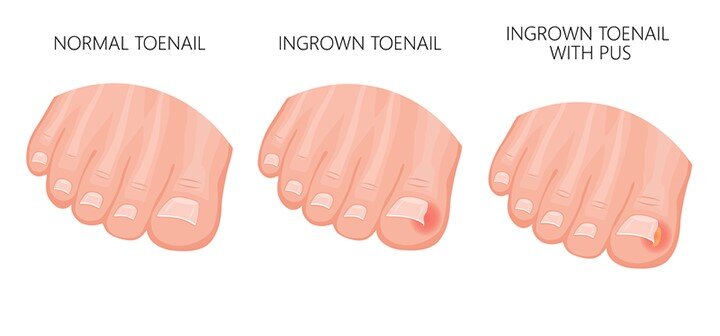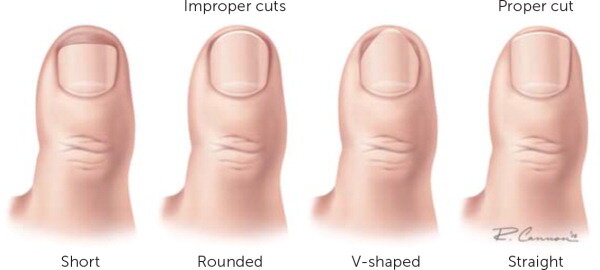When finding out you have an ingrown toenail, the first thing you want to do is to remove it! But there is a lot to learn about doing so, such as the ingrown toenail removal cost and what to expect upon doing so. It’s also important to know about the condition, seeing why it occurs and how to get rid of the ingrown.
If you don’t know where to start, then read on! I’ll tackle everything to know about the condition, the surgery, insurance, and cost associated with it.
What Is An Ingrown Toenail?
An ingrown toenail occurs when your nail edges and/or corners grow into your skin, next to the affected area. The big toe is the one most likely to get an ingrown.
Ingrown toenails can appear in both men and women, more common in those who have sweaty feet. Seniors are also at higher risk of ingrown toenails or a toe infection because nails tend to thicken as we age.
Other than that, there are more reasons why ingrown toenails occur, as well as why they thicken and curl:
Ingrown Toenail Removal Cost & Medical Reimbursements
Now, on to the ingrown toenail removal price, cost differences, and health insurance. How much should you expect to shell out? The cost depends on your health insurance and the type of procedure done, as well as your podiatrist’s area and reputation.
Note that if you need to remove one part of your toenail or any excess tissue, it will cost between $100 to $300. The cost already includes local anesthesia, with exact cost, again, depending on the state you are from.
If more than one toe needs to be cared for, then expect the cost to ramp up to $1,000 or more. That’s why it’s better to go with insurance and call your company to see if you can be reimbursed for it rather than shoulder the entire cost.
Fortunately, insurance covers such procedures. Because of this, the cost of ingrown toenail removal can either be covered by insurance fully or only 10-15% of your total bill. Urgent Care may be able to take care of such surgery procedures, but only if deemed necessary.
If the ingrown toenail causes a lot of discomfort and is already bleeding or oozing pus, you may need to see Urgent Care for it, which insurance may cover at the same cost, depending on your insurance company. While they can treat the toenail if there is an infection, it’s better to see your doctor (a podiatrist) for it to save on any extra cost from Urgent Care.
I highly recommend that you treat the problem early on so you’re able to use your insurance for it and save on the cost. Visit your podiatrist when you see signs of discomfort already that looks like it can lead to infection. But if you have no insurance and it doesn’t feel too serious, you may learn how to fix an ingrown toenail on your own to skip the podiatrist visit and hefty cost.
What Does an Ingrown Toenail Look Like (Symptoms)?

You will know if you are suffering from ingrown toenails if they look like this:
If left untreated, the ingrown toenails can become more infected and it will look like this:
That’s why it’s crucial to treat your toenails to avoid symptoms from worsening by going to your podiatrist or other medical professionals. If you want to know even more about this condition, here is a detailed video explaining the condition:
What Is Ingrown Toenail Removal?
You will know if you have ingrown toenails not only by the symptoms mentioned above. Visit your podiatrist or chosen medical professional, who will diagnose the ingrown toenail and foot from a physical exam.
If the ingrown toenail looks infected, then you may need X-rays to show how much your nails have grown into your skin. It will also show the cause of your ingrown toenail.
Depending on the intensity of your condition, the podiatrist may recommend its medical removal or a specific ingrown toenail treatment. There are different types of treatments and procedures for ingrowing toenail removal, but typically, it involves an ingrowing toenail surgery procedure.
There is partial ingrown nail removal, which only removes the small piece of nail currently digging to the toe. Total ingrown nail removal is used if the ingrown was caused by thickening. Your entire nail will be removed using a matrixectomy from your podiatrist.Both these procedures can remove the ingrown toenail permanently, though you have to care for your foot better afterward.
What To Expect During Ingrown Toenail Removal
Fortunately, you can treat the affected ingrown nail yourself if you see them at earlier stages. However, if your toe has become infected, you’ll need to seek medical attention. Your podiatrist or doctor will either prescribe medication or recommend an ingrown toenail surgery procedure to be done.
Ingrown toenail surgery is necessary when there are signs of infection, especially if you have a medical condition affecting your health gravely. For those who have diabetes, poor circulation, nerve damage, or other health problems, it’s best to see a doctor for professional advice and to remove the ingrown toenail immediately.
So, what procedure should you choose when knowing how to get rid of an ingrown toenail?
Here are the different (and common) ingrown toenail surgery and procedure list to remove the affected ingrown toenail, as well as what to expect from each procedure:
The Recovery Process – Is Ingrown Toenail Removal Painful?
When hearing ingrown toenail surgery, we automatically presume that it will be a scary process. When it comes to ingrown toenail removal, the ingrown toenail surgery does NOT hurt. Any procedure you choose is naturally painless, depending on how you choose to numb your toe.
You may feel some stinging and numbness from local anesthesia the podiatrist gives, though it only lasts for less than a minute and you won’t feel much discomfort. It only feels like it’s being filled with hot fluid. The intensity of the pain and discomfort does vary from person to person, as we all have different pain tolerances.
After the procedure, you may also feel a bit of soreness in the affected area. Some patients have reported that their toes throb a bit or feel tender during the first one to three days. This is normal and can be relieved with over-the-counter pain medication, which your podiatrist or doctor should recommend.
If you choose to treat the condition yourself, there may be a bit of swelling felt from the ingrowing toenail home remedy you followed. But this is rare and only if you did not follow the home care instructions well. If the ingrown toenail home remedy went wrong, visit your podiatrist to have it fixed before it gets too infected.
Either way, the entire ingrown toenail removal process isn’t as daunting as you would expect and you can go through procedures without much discomfort. It will take only one to six days for the ingrown toenail to heal, and you can expect to perform exercises again after two weeks. You just need to follow doctor’s orders and care for your feet during and after the recovery process, and visit the podiatrist as required, which I’ll explain later on.
Total Anesthesia vs. Sleeping During The Procedure
There are two ways to prepare/sedate your ingrown toenail for the procedure: You can either be put to sleep or use anesthesia for the ingrown toenail surgery.
If given the choice, it’s recommended to undergo general anesthesia rather than sleep it off before the ingrown toenail surgery. Being administered anesthesia does not mean your entire body will be fully sedated, so there’s nothing to worry about. Anesthesia is best to avoid feeling too much discomfort during the procedure, especially if it’s a child or if your toenail has become seriously infected before the ingrown toenail surgery.
During the ingrown toenail surgery, the podiatrist or doctor will simply use a digital block to inject an anesthetic to the nerves around the affected toe. It may sting a bit, but there will be no major pain or side effects felt. And yes, you will be awake during the ingrown toenail surgery. You just won’t feel the procedure being done in the affected area.
Other Ways to Stop and Prevent Ingrown Toenails
Now that you’re familiar with what ingrown toenails are, how the surgery procedures go, and its cost, what home treatments can you do without the podiatrist for ingrown toenail surgery? I’ll be showing you the various ways to stop this using the home treatment, as well as ways to care for your feet better to prevent it from coming back and hurting much more.
Foot Soak With Epsom Salts
If your toes feel swollen and painful, I recommend that you soak it in warm and soapy water. Do this three times a day for half an hour each time, using Castile soap for its health benefits. This is recommended if nail surgery or other ingrowing toenail treatment isn’t absolutely necessary.
Adding in Epsom salts is also recommended which can add more relief without excessive cost. Saltwater is great for ingrown toenails to reduce any aching and discomfort. After soaking your feet, dry your feet with a clean towel well.
Apple Cider Vinegar
Another way to help ingrown toenails without the high cost is by soaking your feet in apple cider vinegar. This is because it’s believed to be anti-inflammatory and anti-septic, which helps in relieving pain. While there still needs to be more studies on this, it’s still worth the shot and won’t require ingrown toenail surgery yet!
Do this remedy by preparing a small tub of warm water mixed with a quarter cup of apple cider vinegar. Soak the feet once a day for up to 20 minutes each time. Afterward, dry your feet thoroughly.
Antibiotics
Your doctor might prescribe you oral antibiotics, however, these aren’t routinely prescribed if your feet are uninfected. Because of this, antibiotics CANNOT cure your toenails completely. There isn’t much evidence showing how they improve your toes BUT may help to treat an infection or weakened immune systems.
However, if the foot is infected already, you will need ingrown toenail surgery.
If you do require antibiotics to treat infection, with or without ingrown toenail surgery, you may need to take either ampicillin, vancomycin, or amoxicillin. Using hydrogen peroxide MAY also help comfort the area around your toenails. Place a few drops of it on a clean cotton pad and rub it directly on the affected area. This can kill bacteria and infection from the affected area.
Medication and Creams
Before you go to the doctor to see if you need ingrown toenail surgery, you can also consider using over-the-counter creams and ointments, which can help heal and reduce the risks of infections. Make sure that you apply the cream following instructions from the manufacturer, usually doing so thrice a day.
Recommended antibiotic creams include Neosporin, Bactroban, or Polysporin. After application, make sure you bandage your toenail to prevent stubbing and exposure to dust and the like.
Cut It Yourself

If there isn’t any infection and you caught the ingrown toenail during its early stages, you can cut it off yourself and avoid ingrown toenail surgery. Follow these steps to do so:
Prevention Tips
Once your ingrown toenail has healed, whether you underwent ingrown toenail surgery or not, you need to make sure you care for your feet properly. This prevents the condition from coming back since they can recur without the high cost. Follow these prevention tips:
Ingrown Toenail Removal Cost Frequently Asked Questions
What will happen if you leave an ingrown toenail untreated?
If you leave your toes untreated, there’s a risk of infection and need for surgery. Not only does this affect your toenail, but it can cause infections in the bones of your toe such as tissue decay or tissue death. This can lead to more serious conditions such as open sores, foot ulcers, or even a loss of blood flow around the infected area. It may also be more serious if you have other conditions such as diabetes. That’s why if left untreated, it WILL require surgery, which will cost you more.
Why does my ingrown toenail hurt so bad?
One of the common symptoms of this condition are aches and swelling. You may also experience throbbing when placing pressure on your toe from the tenderness and any fluid buildup.
If your toenail hurts so bad, then this might indicate a bad infection and you’ll need to have it checked with your podiatrist immediately for surgery.
Can I cut out my ingrown toenail?
It is possible to cut out the nail’s affected area on your own. However, there are some things to consider before doing so.
If your toenail isn’t infected and still at its earlier stages, you can still cut it yourself without surgery. But if it is now infected or you’re unsure of how to remove it on your own, it’s best to see a podiatrist for it to undergo surgery or be prescribed medications.
How long do ingrown toenails last?
This can last depending on how long you leave it untreated. It can take a few days to weeks for it to worsen if you ignore the symptoms, not healing on its own. After you have it treated on your own or from surgery and medical procedures, it can heal in up to two weeks.
How long do I keep the bandage on after ingrown toenail removal?
You will need to keep it on for at least one week, as it will take two weeks for the toe to completely heal.
How do I permanently get rid of an ingrown toenail?
The home remedies suggested above are ways you can get rid of the ingrown toenail, however, it may not be permanent. The only way you can ensure a permanently removed ingrown toenail is through medical procedures AND proper foot care after it has healed.
How to treat an infected toe?
Infected toes will require an immediate doctor’s visit, as over-the-counter antibiotics and topical creams can only do so much. You will need to have prescribed medication for it to prevent it from further infection.
When should I go to the doctor for ingrown toenails?
It’s best to see your doctor as soon as possible, once you see any symptoms. If you ever feel a lot of pain and swelling, as well as experience pus oozing or bleeding, then that’s a sign of infection and you need to see your doctor immediately for surgery. Do NOT delay the doctor’s visit and surgery if serious symptoms appear or it can lead to other conditions.
Can I wear shoes after ingrown toenail surgery?
You’re allowed to wear shoes right after surgery, but if you can, stay barefoot and keep your feet clean. If you must, only wear loose-fitting shoes or open-toed sandals during the first two weeks right after the surgery procedure. Do NOT wear any high-heeled or tight-fitting footwear, which can cause discomfort and adversely affect your toes’ recovery.
Can I walk after ingrown toenail surgery?
Yes, you are allowed to walk after the surgery, but if you can, rest for a day or two after the procedure. Avoid placing too much pressure on your feet from excessive walking or activities, such as sports. You can go back to your sports after two weeks of recovery, provided you use protection.
Can I go swimming with an ingrown toenail?
You can swim with the condition, but it can be quite painful while you move, or from any chemicals if you have infections already. Furthermore, people may find it unhygienic, which will cost your respect, so have it treated before taking on any activities like this.
What is a pincer toenail?
A pincer nails a type of ingrown, but a more painful type. It means an excessive curving of your nail plate, which causes it to pinch into the area around it.
The pincer nail looks like a C-curve on the nail so you can see its ends pushing into the area. This is different compared to the ingrown toenail, which affects only one side and does not have a clear C-shape.
While it has its differences, they have similar symptoms, remedies, and removal cost. Pincer toenails are just much more painful.
Wrapping It Up
Learning about treating ingrown toenails can be quite confusing, with the many options you can consider. But don’t worry, as the ingrown toenail removal cost isn’t as huge as you’d expect, and insurance can cover it. As long as you have a reputable doctor to work with, you’re given various options to get rid of the aches and discomfort.
I hope you learned a lot about ingrown toenails and your options on treating it. If you think you have this condition, visit your doctor to find out what you can do and the exact costs now.
Do you have questions or would like to share your insight and experiences on the topic, comment below. All of your input is much appreciated!






